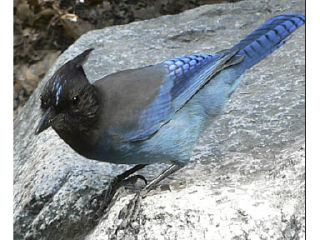Steller’s Jays are bold, curious, and resourceful.
Birds have long been symbols of freedom of movement. Yet while birds freely travel great distances, they are still limited by habitat: adequate food and suitable places to nest out of the reach of predators. The patchy and changing distribution of island birds illustrates this point.
Let’s begin with Steller’s Jay, our large raucous western blue jay. Like other jays and crows, they are clever, aggressive and omnivorous, and widely distributed throughout the mainland areas of Washington. They were also common residents of the islands, until they nearly vanished in the 1920s. Today, Steller’s Jays are largely restricted to the west lobe of Orcas, mainly Turtleback ridge. Elsewhere they are only occasional visitors. Can we explain their current distribution or their historically diminished range?
Steller’s Jays throughout the Pacific Slope are attracted to sources of acorns and conifer seeds (“pine nuts”), which they cache for winter use, but they are omnivorous and will also eat fruits, insects, even rodents and other birds’ eggs, especially when they have nestlings to feed. Like their close cousin, the eastern Blue Jay, they have also adapted to living amongst humans, scavenging around homes, and using bird feeders.
Steller’s Jays seem to play a role in the dispersal of Garry oaks on Orcas, caching acorns under logs and rocks where clusters of oak seedlings later appear. They are absent from the large oak aggregations on San Juan Island and Waldron, however, and appear to be thriving on the coniferous north slopes of Turtleback where there are few if any oaks.
Deforestation may partly explain the history of island jays. Clearing for pastures, fields and orchards, combined with commercial logging, increased from the 1880s to the 1920s, when very little of the islands remained forested. Steller’s Jays would have found little winter food and few places to nest, unlike birds of fields and meadows. Sightings of Pileated Woodpeckers were rare in the 1930s; then increased as island forests grew back. But Steller’s Jays did not rebound fully. Could competition from the arrival of European Starlings in the 1950s have been a factor?
Staying with a blue theme, consider the Western Bluebird. In his 1923 handbook, Birds of the Pacific Coast, Eliot described the habitat of this beautiful insectivorous bird as “open country, about clearings, farms, orchards and along country roads where it may be seen perched on telephone poles and wires.” The definitive Birds of Washington State (1953) likewise described these birds as “commonly found along roadsides or about farm buildings, or even in the streets of towns in the more settled districts, and in open woods such as yellow pines in the uncultivated sections.”
Bluebirds were widespread summer residents of the islands in the 1930s, but most recorded sightings were concentrated on the dry slopes of south and west San Juan Island where they reportedly preferred “fields, farmland, and bordering shrubbery” including the still widespread orchards and animal pastures. By the 1960s, bluebirds were a rare sight on any of the islands. Were bluebirds victims of declining agriculture and the re-growth of island forests? Or a change in the composition of our forests, which appear to be more coniferous (chiefly Douglas fir) today than 100 years ago, when we had larger deciduous woodlands—mainly willows, alders, and aspens as well as some oak patches—with more opportunities for cavity-nesting birds?
We may never fully understand the reasons for the patchy distribution of Steller’s Jays, or the decline of Western Bluebirds in the islands. But birds are clearly a sensitive indicator of changes in upland habitats due to human activity or climate change. Annual island-by-island bird counts are an important contribution. We should also pay attention to changes in the habitats that birds use on each of our islands, and to nesting times each year, which can reveal climate trends.
For information on Christmas bird counts and related activities in the islands refer to the website of the local chapter of the Audobon Society, www.sjiaudobon.org. And be sure to contact Wolf Hollow Wildlife Rehabilitation Center, 378-5000, to report injured birds or grounded nestlings.



